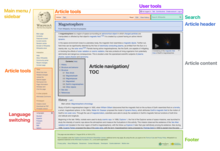Czytanie/Sieć/Ulepszenia interfejsu
|
Ulepszenia interfejsu na komputery stacjonarne
Seria funkcji i przemeblowanie skórki Wektor
|
Poprzednia domyślna skórka wiki Wikimediów (Wektor) została wdrożona w 2010 roku. Przez następne dziesięciolecie interfejs zostawał wzbogacony poprzez rozszerzenia, gadżety oraz skrypty użytkowników. Większość z nich nie było koordynowane pod kątem wizualnym i dostępności na wielu wiki. Przez ten czas sposób projektowania stron internetowych oraz oczekiwania czytelników i redaktorów ewoluowały. Nadszedł czas, aby niektóre pomysły zostały wdrożone do domyślnego działania strony dla wszystkich użytkowników, na wszystkich wiki, w sposób spójny i zorganizowany.
Between 2019 and 2023, we were building a new skin. Naszymi celami jest sprawienie, by wiki Wikimediów były przyjaźniejsze, zwiększenie użyteczności dla czytelników i utrzymanie jej dla już działających edytorów. Mierzyliśmy poziom pozytywnych odbioru i zachowań oraz użyteczności naszych stron (na przykład poziom tak powszechnych działań, jak wyszukiwanie czy zmiana wersji językowej).
In 2022, the new skin became ready to be the default. Since then, we are introducing it on more and more wikis. Ultimately, we need to have one skin as the default everywhere. This is because keeping two as the default indefinitely is impossible.
Aktualizacje
Jaki był nasz cel?
Wyobraź sobie garderobę
-
Moglibyśmy ją stopniowo przerabiać z tego…
-
…na to :)
Poprzednio, interfejs…
…nie spełniał oczekiwań. …był zagracony i nieintuicyjny. …nie wyróżniał strony społecznościowej. …nie był spójny z wersją mobilną.

- Interfejs desktopowy nie spełniał oczekiwań stworzonych przez nowoczesne platformy sieciowe. Był dezorientujący i niespójny. Nawigacja i linki interfejsu były chaotyczne.
- Readers were unable to understand the purpose, terminology, and concepts of available tools such as the main menu, user menu, and page tools.
- Editors found the hierarchy of the navigation to be confusing for newcomers.
- Editors and other contributors wanted easier access to tools they used frequently.
- Editors expressed interest in having fewer, but more prominent, ways to begin contributing.
- Obecnie panuje nieład, który rozprasza użytkowników od tego, po co przyszli. Czytelnikom jest trudno skupić się na treści. Intuicyjne zmiana języków, wyszukiwanie treści czy dostosowanie ustawień czytania są dla nich niemożliwe. Nowi użytkownicy nie mogą użyć intuicji przy zakładaniu konta, otwieraniu edytora czy uczeniu się, jak używać stron niebędących artykułami w celach moderacyjnych.
- Too much information density and navigational elements on the page made it difficult to focus on a particular reading or editing task.
- Readers found it difficult to navigate the page and spent a lot of time scrolling.
- Readers found it difficult to search for information that is relevant to them.
- Multilingual readers were not aware of language switching functionality.
- Readers wanted to have an easy way to view the table of contents throughout the page.
- Character count per line was more than three times the recommended value.
- Bardzo mały procent czytelników rozumie, jak funkcjonują wiki Wikimediów. Wielu z nich nie jest świadomych, że treści, które czytają, są przez wolontariuszy tworzone i często zmieniane, ani że sami czytelnicy także mogą edytować.
- Duża różnica między wrażeniami przy używaniu interfejsu komputerowego, aplikacji mobilnych i przeglądarek mobilnych utrudnia czytelnikom powiązanie ze sobą stron widzianych w różny sposób. Nie ma wizji wspólnej dla wszystkich stron Wikimediów.
Jak zmiany zostaną wprowadzone
Zasady
Nie zmieniamy treści. Nie zmieniamy innych skórek niż Vector. Nie usuwamy żadnej funkcji. Nie robimy dużych zmian naraz.
- Pracujemy tylko nad interfejsem. Nie będziemy zajmowali się wyglądem szablonów, strukturą treści stron, mapami czy globalnymi szablonami.
- Skórki inne niż Vector są poza naszym zainteresowaniem. Zatrzymaliśmy Vectora, nazwaliśmy go Legacy Vector i zaczęliśmy wprowadzać zmiany jako składniki nowego wyglądu Vectora.
- Elementy interfejsu mogą być przemieszczane, ale wszystkie elementy nawigacyjne i inne dotychczas dostępne funkcje pozostaną dostępne.
- Mimo że nasze zmiany łatwo zauważyć, podchodzimy do nich ewolucyjnie i chcemy, żeby, z perspektyw czytelników i edytorów, zachowanie strony było takie samo. Każda zmiana jest omawiana, rozwijana i wdrażana osobno.
Process for developing the features
- 2019: Problem identification research with both readers and editors – We studied the way people used the site. We identified the largest usability issues as well as obstacles in becoming more engaged with reading or editing. We did this by interviewing readers and editors across multiple countries and locations. We also surveyed gadgets and user scripts. Some of them deserved to be surfaced and be a part of default experience. (See the links: Research and design: Phase 1, Research and design: Phase 2.)
- 2019–2022: Prototype development and testing – We built out the ideas for features and began showing prototypes. Each feature was tested with readers and editors through interviews and on-wiki prototype testing. We used Central Notice banners across multiple languages and Wikimedia projects. Each prototype was tested by approximately 200 editors on average. (Example)
- 2020–2023: Refining and building – We refined or changed the features based on the outcomes of the prototype testing. In some cases, we asked for additional opinions to ensure we were making the right decisions.
- 2020–2023: A/B testing and other quantitative testing on wikis – This was the "beta" phase:
- We performed tests for whether the features worked as expected based on the previously defined criteria of success. We made "before and after" comparisons or performed A/B tests. As the latter, we gave a new feature to 50% of users and compared them to the other 50%. After two weeks we compared the results.
- If we received negative results, we identified the reasons across different audiences and made changes to the feature. Then, we would test the feature again. In the case of significantly negative results, we rolled back our changes. (Example)
- Chcemy, żeby nasze poprawki były testowane we współpracy z różnorodnym gronem wolontariacko zgłaszających się społeczności, zarówno Wikipedii, jak i projektów siostrzanych.
- We also monitor usage across all wikis, where many account holders have been already using the new skin.
- 2022 – onwards: Deployments on more and more wikis – The results of testing and subsequent analysis concluded that our changes result in improved usage of the skin, and save time previously spent in scrolling, searching, and navigating. We interpret this as an easier and more comfortable reading experience. There are no negative effects to pageviews, account creation, or edit rates. Knowing this, we continue to roll out the skin on more and more wikis.
Jakie funkcje zostały dodane
Plan wdrożenia i oś czasu
Skórka jest już gotowa, więc może stać się domyślna na dowolnej wiki.
| większość wiki | wcześnie używające wiki |
|---|---|
| edytorzy i czytelnicy domyślnie nie widzą zmian |
edytorzy i czytelnicy domyślnie widzą zmiany |
| tylko zarejestrowani mogą je włączyć (z poziomu preferencji, poprzez zaznaczenie Wektor (2022) w zakładce Wygląd) |
tylko zarejestrowani mogą je wyłączyć (używając linku Przełącz na stary widok w menu bocznym lub z poziomu preferencji) |
| Year | Month | Deployments |
|---|---|---|
| 2019 | maj | First team discussions |
| 2020 | lipiec/sierpień | The new logo, collapsible sidebar, and limited content width introduced on the first early adopter (pilot) wikis, including French Wikipedia |
| wrzesień | The new search widget is introduced | |
| 2021 | czerwiec | The new language switching is introduced |
| luty | Deployments on more pilot wikis, including Bengali, Korean, and Portuguese Wikipedias | |
| 2022 | sierpień | The new user menu is introduced |
| styczeń | The new sticky header is introduced Deployments on more pilot wikis, including Indonesian, Thai, and Vietnamese Wikipedias | |
| luty | The changes are separated out from the Vector legacy code to a new skin "Vector 2022" | |
| maj | The new table of contents is introduced | |
| czerwiec | The skin is introduced on the last pilot wikis, including Catalan and Japanese Wikipedias The first visual refinements are introduced | |
| październik | Deployments on the smallest Wikipedias | |
| listopad | The new full/limited-width toggle button is introduced | |
| grudzień | Deployments on Arabic and Greek Wikipedias | |
| 2023 | styczeń | Deployment on English Wikipedia |
| luty | The full/limited width preference becomes persistent for logged-out users | |
| marzec | The new page tools menu is introduced | |
| kwiecień | Deployment on Polish Wikipedia | |
| maj | Deployment on Spanish Wikipedia | |
| sierpień | Deployment on Chinese (zh) and several smaller Wikipedias | |
| październik | Deployments on Swedish, Hungarian, Dutch, Hindi, Norwegian bokmål Wikipedias Also on Meta-Wiki and most Wikibooks, Wikinews, Wikiquotes and Wikiversity wikis | |
| listopad | Deployments on most Wikivoyages and Wiktionaries The last visual refinements (known as Zebra 9) are introduced | |
| 2024 | marzec | Deployments on most Wikisources and Foundation internal wikis |
Zaangażuj się, kontakt
- * Testuj indywidualnie: zaznacz opcję Wektor (2022) w preferencjach. Możesz także włączyć nasze zmiany w preferencjach globalnych.
- Pomóż w komunikacji: informuj swoją społeczność. Dziel się linkami do aktualizacji i postów z bloga.
- Zgłaszaj błędy: aby zgłosić błąd, utwórz zadanie na Phabricatorze i użyj znacznika #Desktop Improvements Vector 2022.
- Przetłumacz: pomóż nam, tłumacząc powiązane strony:






